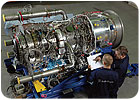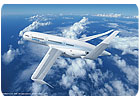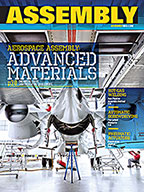
If there was a “poster child” for the green aerospace movement, the honor would belong to Boeing’s much-anticipated 787Dreamliner. When it debuts next year, the 787 will be the first mass-produced, environmentally friendly airliner. It features a lightweight carbon-fiber airframe and fuel-efficient engines.
TheDreamlinerconsumes 20 percent less fuel compared to similar-sized airplanes. In addition, widespread use of composite panels helps reduce its weight and boost production efficiency. For instance, 80 percent fewer fasteners are required to assemble the 787.
While the long-delayedDreamlinerhas been capturing most of the front-page headlines recently, many other sustainable initiatives are underway in the aerospace industry. OEMs and suppliers are investing billions of dollars in green technology, such as advanced jet engines, batteries, biofuels, electric architectures, fuel cells, solar panels and lightweight materials. The goal is to create aircraft that fly more economically, quieter and cleaner.
“Both the commercial and military sectors are pursuing green activities,” says John Halat, aerospace chief engineer for advanced technology at Eaton Corp., a leading supplier of components, such as avionic switches, cockpit controls, fuel pumps, hydraulic systems and landing gear. “However, since the commercial sector has the biggest potential impact on sustainability, most of the effort is in this sector.”
The Federal Aviation Administration (FAA) recently announced $125 million in contracts to develop and demonstrate technologies that will reduce commercial jet fuel consumption, emissions and noise. The contracts are part of the FAA’s Continuous Lower Energy, Emissions and Noise (CLEEN) program.
Boeing, General Electric, Honeywell, Pratt & Whitney and Rolls-Royce will use the FAA funds to research and demonstrate a variety of technologies over the next five years, including sustainable alternative aviation fuels; lighter and more efficient gas turbine engine components; noise-reducing engine nozzles; advanced wing trailing edges; optimized flight trajectories using onboard flight management systems; and open-rotor and geared turbofan engines.
“The goals of these efforts include a reduction in fuel burn by 33 percent, a reduction in nitrogen oxide (NOx) emissions by 60 percent and a reduction in cumulative aircraft noise levels by 32 decibels,” says Randy Babbitt, FAA administrator. “The CLEEN program [will] develop environmentally friendly and energy-efficient aircraft and engine technology that could be introduced into the commercial aircraft fleet beginning in 2015.”
The FAA program is patterned after the European Union’s Clean Sky initiative, which is one of Europe’s largest research programs, with a budget of 1.6 billion euros. The collaborative private-public partnership includes aircraft manufacturers, universities and research centers. It aims to make air travel more sustainable, while encouraging the aerospace industry to develop and produce greener products.
According to the United Nations Intergovernmental Panel on Climate Change (IPCC), the aviation industry currently produces 2 percent of the world’s manmade emissions of carbon dioxide. As the industry grows to meet increasing demand over the next few decades, the IPCC predicts that aircraft emissions will increase to 3 percent.
“The aerospace industry can have a significant impact on the environment,” says Mark Lewis, president of the American Institute of Aeronautics and Astronautics (AIAA). “However, aircraft are already quite efficient. The industry has constantly improved the efficiency of its power plants.”
For example, today’s jetliners generate 70 percent fewer emissions and have a 90 percent smaller noise footprint than commercial airplanes from the 1960s, such as the Boeing 707 and the Douglas DC-8. On the 707, all four jet engines had to be removed after every 500 hours of use to be inspected and rebuilt. In sharp contrast, contemporary twin-engine airliners typically only receive that kind of attention after more than 20,000 hours of use.
“Future developments in green aerospace will focus on fuels, propulsion systems and airframes,” says Lewis, who also serves as chairman of the aerospace engineering department at the University of Maryland. “We’re already good at all these things. Making them better will require some significant leaps in technology.”
For instance, at the recent Farnborough International Airshow, Airbus unveiled a concept of what a green jetliner may look like in a few decades. It features ultra long, slim wings, semi-embedded engines and a U-shaped tail. The interior boasts morphing seats made from ecological, self-cleaning materials that change shape to fit individual passengers.
“The concept plane represents an engineer’s dream about what an aircraft could look like in the long-term future,” says Charles Champion, executive vice president of engineering at Airbus. “Green energy sources like fuel cells, solar panels and even our own body heat might provide energy for powering some systems on tomorrow’s aircraft. As aeronautics engineers continue to use nature as a source of inspiration, some of these aircraft may even fly in formation like birds to reduce drag, fuel burn and emissions.”
The National Aeronautics and Space Administration (NASA) is leading the green aerospace charge among American aircraft manufacturers. “The long-term goal is to achieve a 75 reduction in NOx by 2030,” says Ruben Del Rosario, principal investigator for NASA’s Subsonic Fixed Wing Project. “Another goal is to improve local air quality and address environmental issues, such as engine and airframe noise. Engine noise is more of an issue during takeoff, while the airframe is more of an issue during landing.”
According to Del Rosario, aerospace engineers are focusing much of their attention on fuel burn reduction and propulsion efficiency. “The development of advanced combustors is the key to optimizing efficiency and generating the least amount of NOx as possible,” he points out. “We’re also looking into active combustion controls to optimize the combustion process.”

Propulsion Progress
Del Rosario and his colleagues at NASA are urging commercial airline manufacturers to develop engines that require less power on takeoff to reduce noise. But, the challenge is to also create propulsion systems that are ideal for operating at higher altitudes and lower cruising speeds-about Mach 0.7, which is 5 percent to 10 percent slower than today’s aircraft-to save fuel.For instance, engineers at Rolls-Royce are developing a new two-shaft jet engine that promises to be fuel-efficient and environmentally friendly. Called the E3E, it uses cutting-edge technology to increase engine temperature, pressure ratio and component efficiencies. It has a 25 percent better thrust-to-weight ratio than existing engines. It reduces fuel burn and CO2 emissions by 15 percent, compared to similar engines currently in service.
“E3E technology includes a two-stage shroudless high-pressure turbine incorporating advanced 3D aerodynamics and blade cooling technology; a novel tip clearance control system with advanced ceramic abradable linings to improve turbine efficiency and increase performance retention; a lean-burn combustion system; a blisked high-pressure compressor; and an innovative air system for bearing load management and improved cooling using novel carbon oil seal and brush-seal air sealing technologies,” says Mark King, president of the civil aerospace division of Rolls-Royce.
Not to be outdone in the green race, Pratt & Whitney has been developing a new engine called the PurePower PW1500G. It features an advanced gear system that allows the engine’s fan to operate at a slower speed than the low-pressure compressor and turbine.
The combination of the gear system and an all-new advanced core delivers double-digit improvements in fuel efficiency and emissions with a 50-percent reduction in noise over today’s engines. The engine is expected to enter service in three years on Bombardier’s CSeries regional aircraft.
The U.S. Air Force Research Laboratory recently announced Phase II funding for GE Aviation’s demonstrator engine core and critical components for the ADaptive Versatile ENgine Technology (ADVENT) program. It is developing a variable engine cycle, greater component efficiencies, and new materials to provide future military and commercial aircraft with far greater range and mission flexibility.
For the past two years, GE engineers have been engaged in Phase I of ADVENT, which involved preliminary and detailed design, analysis and risk-deduction activities. The development work involved running a full annular combustor rig, component and rig tests using ceramic matrix composite materials, and testing of a full core engine consisting of the compressor, combustor and high-pressure turbine.
“Several key technologies will be demonstrated in Phase II, including a hot section featuring ceramic matrix composites, a high-pressure ratio core and an advanced variable pressure ratio fan, and GE’s next-generation cooled turbine,” says Jeff Martin, general manager for the ADVENT program. “These technologies, if successfully demonstrated, will find a home on [future] GE jet engines.”
General Electric is also working with NASA’s Glenn Research Center to develop a new generation of open-rotor aircraft engines, which feature two high-speed propellers on the outside. The unique shape and design of the propellers allow airplanes to fly at speeds much closer to aircraft using traditional jet engines.
Del Rosario says counter-rotating propellers improve fuel efficiency, but increase the amount of noise produced. Careful design of the open rotor blades is required to reduce the noise both inside and outside the passenger cabin.
“Our goal is to validate noise reduction with an open-rotor system while still getting a good fuel-burn performance metric,” notes Brian Fite, chief of the acoustics branch of NASA Glenn. “Quieting the noise to make open rotors acceptable to the flying public is a major technical challenge.”
To achieve greater efficiencies, green aircraft engines must run at higher temperatures and be cooled with more intricate schemes. As aerospace engineers look for new materials that improve fuel efficiency, advanced ceramics and high-performance superalloys will play a key role.
Ironically, one of the oldest types of joining processes will play a key role in assembling state-of-the-art green aircraft engines. New high-performance metal brazing alloys are ideal for sealing ceramic-to-metal pressure sensors, temperature sensor components and thermocouple housings.
For instance, brazing technology is being used to assemble the solar-electric propulsion system used inBepiColombo, Europe’s first spacecraft mission to Mercury, which is expected to launch in 2014. The propulsion system, which is being manufactured by QinetiQ Group PLC for the European Space Agency’s mission, uses brazed ceramic and metal assemblies to isolate components in the thrusters from extreme high voltage.
“Brazing is providing a much stronger and simpler solution compared to alternative methods of joining ceramic and metal, resulting in a more reliable and robust system,” says Yannick Galais, commercial manager at Morgan Technical Ceramics.
“There are many components and subassemblies within the thruster that operate at different voltages and need to be isolated from each other,” Galais points out. “Fitting the assemblies with isolators that have been brazed to a threaded termination or flange results in a stronger, rigid and more simplified joint.”

Emerging Technology
In the future, fuel cells, solar panels, electric motors and other green components will play an important role in aircraft. “Aerospace engineers tend to be very conservative, but there’s a paradox,” says AIAA’s Lewis. “At the same time, they’re constantly pushing the envelope and exploring state-of-the-art technology.”
Some of the latest green achievements have come in the form of solar-powered aircraft. For instance, QinetiQ engineers recently set a world record with their unmanned Zephyr, which features a 22.5-meter wingspan. The hand-launched aircraft stayed aloft for more than 14 days, despite constantly changing weather conditions, during a test in Arizona.
“The Zephyr airframe incorporates totally new approaches to aerodynamics, structures, propulsion, avionics, flight controls, power system management, thermal control, ground control station design, and payload, as well as overall operating processes,” claims Chris Kelleher, QinetiQ’s chief design engineer.
The aircraft flies by day on solar power delivered by amorphous silicon solar arrays that cover the wings, no thicker than sheets of paper. The arrays are also used to recharge the lithium-sulphur batteries that are used to power the aircraft by night. “Together, they provide an extremely high power-to-weight ratio on a continuous day-night cycle, thereby delivering persistent capabilities,” explains Kelleher.
A team of Swiss aviators plan to fly around the world in a solar-powered aircraft in 2012. The Solar Impulse features a 64-meter wingspan. It recently stayed aloft for more than 26 hours during a test flight in Switzerland. More than 10,700 solar cells cover the plane’s wings, which contain four electric engines.
Engineers at EADS Innovation Works have been studying a wide variety of electric propulsion systems. They recently unveiled a single-seat, all-electric plane dubbed Cri-Cri. Lithium-ion batteries power four brushless motors, which drive counter-rotating propellers.
The EADS team has also developed a hybrid helicopter that uses electric motors to drive the rotors, combined with diesel engines, to reduce fuel consumption and emissions by up to 50 percent. Take-offs and landings are possible on electrical power alone with the Eco2Avia, resulting in lower noise levels.
“The main components of this patented hybrid system are multiple diesel-electric motor-generator units, a pair of high-performance batteries, and a power electronics unit controlling the energy flows for best efficiency,” says Jean Botti, chief technical officer at EADS, the parent company of Airbus and Eurocopter. “The opposed piston, opposed cylinder (OPOC) diesel engines offer a fuel economy improvement of up to 30 percent compared to today’s helicopter turbine engines.
“The OPOC engine’s power output shafts are fitted with advanced, weight-optimized generators delivering electrical current to the power electronics unit,” Botti points out. “This unit manages the distribution of the electricity to the electrical motors driving the main rotor and the tail rotor to and from the batteries.”
Boeing engineers have been experimenting with a wide variety of fuel cell technologies. In fact, Boeing Research & Technology Europe flew the world’s first hydrogen-powered manned airplane two years ago. A hybrid system consisting of a proton-exchange-membrane fuel cell and lithium-ion batteries powered an electric motor coupled to a conventional propeller in the two-seat motor glider.
In addition, Boeing recently unveiled an unmanned, high-altitude surveillance aircraft called the Phantom Eye. It uses a hydrogen propulsion system to power two 2.3-liter, four-cylinder engines.
Despite those successful applications, many observers believe that fuel cells and solar panels will primarily be used as secondary power-generating systems on aircraft, such as auxiliary power units for large commercial airliners, rather than as primary power units.
“More electric architecture (MEA) will be widely used on future aircraft,” predicts Hans Weber, president of TECOP International Inc., an aerospace consulting firm. “MEA will help aerospace engineers reduce weight and improve fuel consumption, and require less maintenance, resulting in more efficient and cost-effective aircraft. The ultimate goal is to replace oil and fuel pumps with electric systems.”
Learn more about green aerospace trends by reading these Web Extra items:
- Airframe Advancements Lead to Greener Planes
- Blue Skies Ahead for Green Airships?
- Energy Harvesting Creates Efficient Power Management
- Human-Powered Flight-The Ultimate Form of Green Aviation
- Jet Engine Waste Could Power Wind Turbines





